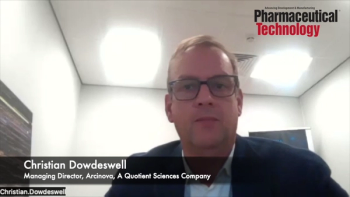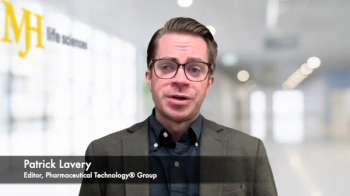
Pharmaceutical Technology Europe
- Pharmaceutical Technology Europe-02-01-2009
- Volume 21
- Issue 2
Consolidation play
The European dose CMO sector appears to be very vibrant, probably more so than the market in the US.
The global economic crisis has not spared the pharmaceutical industry and, by extension, the pharmaceutical contract services industry. The financial prospects for 2009 of CROs and CMOs have dimmed significantly in recent months.
Jim Miller
There are two principal culprits for this downturn. The first is the efforts of major pharmaceutical companies to reduce their costs even as they outsource more. Big Pharma is even exiting entire therapeutic areas and halting early stage projects in those areas. For continuing programmes, they are aggressively looking for ways to cut development expenditures prior to demonstrating proof of concept.
Further, most major pharmaceutical companies have established global sourcing units that are pursuing strategies to reduce outsourcing costs by standardizing processes and reducing the number of vendors that must be qualified, audited and managed. These programmes started 5 years ago in the clinical CRO realm and resulted in companies reducing the number of CROs they work with by as much as 80%. These practices have spread to the preclinical area, and we expect to see a similar pattern for outsourced formulation and manufacturing services.
On the go...
Early development hit hard
The second factor undermining CRO and CMO industries is the uncertainty of funding for early stage companies. Traditional funding sources, such as initial public offerings, follow-on stock offerings and debt, have all but dried up. Venture capital flows have held steady, but investors are funnelling their money to companies in which they already have investments rather than spreading it around. This is because they want to ensure that the most promising candidates in their portfolio companies continue to progress, and because new investors would insist on terms that would greatly dilute the equity positions of the early investors. The problem is particularly acute in Europe where venture capital support for early stage bio/pharma companies has always been weaker than in the US.
To conserve funds, early stage companies with multiple candidates are being forced to shelve less developed candidates to concentrate on those with the nearest and best prospects for commercial approval or out-licensing — while start-ups are having a difficult time getting funding at all.
Service providers that offer early R&D services are being especially hurt by the downturn because there are fewer candidates and less money to spend on them. These include CROs offering discovery, preclinical toxicology, process development and Phase I clinical supplies manufacture. These companies are reporting steep downturns in business activity, and a sharp increase in project cancellations and delays.
Late stage development has not been affected too much yet as candidates closest to commercial approval are being advanced. Contract backlogs at clinical CROs continue to rise despite the general downturn although the timing of projects may suffer.
Uncertain outlook
How long will this difficult environment last? It's hard to say because no one really knows how the financial and economic crisis will evolve and when the funding situation for early pharma will improve. Executives at Covance (NJ, USA), a market leader in the preclinical and Phase I services areas, said in December that they expect market trends to turn positive in mid-year. Many companies were blind-sided by the downturn and don't know what to expect.
The impact on the product pipeline is likely to be long term, however. When the financial markets were flush with cash, many companies and projects received funding they wouldn't have if proper due diligence had been conducted; they got the green light because venture capital investors had to put their large pools of money to work. Now, products and companies with marginal chances of success (and many that may be promising, as well) are not getting funded, meaning the decline in early stage compounds could be sustained for several years.
With less money, fewer compounds and continuing efforts at major pharmaceutical companies to consolidate the vendor base, the number of CROs and CMOs is expected to shrink considerably. Companies that have depended largely on the venture capital-backed companies will have a particularly hard time as their customers seldom have more than one or two candidates in need of services at any one time so they must continually replace their customers with new ones. However, those candidates won't be there.
The survivors will have a strong track record of servicing companies with multiproduct pipelines that can offer repeat business. They will have profitable operations, strong financial positions (little or no debt and positive cash flow) and savvy business development skills. Increasingly, those that serve the largest bio/pharmaceutical companies will have a global network of operations that can support their clients' global ambitions.
Companies looking for vendors are advised to do careful due diligence on those they seek to do business with. Financial condition, including profitability, cash position and debt service requirements, should be a paramount consideration; clients should insist on full financial disclosure, even from privately held companies (of course, contractors should demand the same of their venture-backed clients). Further, some strategic due diligence will be important to make sure the parent company or investor group is committed to the business.
European CMOs consolidating
One part of the industry that is already showing significant signs of consolidation is the European dose manufacturing segment. PharmSource estimates the size of the market at $5.75 billion (€4.29 billion), representing approximately 55% of the global contract dose manufacturing market. Our contractor database counts more than 160 dose manufacturers in Europe. Most impressively, 10 of the largest dose CMOs operate almost entirely from an European network of facilities.
One of the distinguishing characteristics of the European CMO industry of late has been the level of merger and acquisition activity. Major players have been adding facilities or combining operations at a rapid pace, propelled by private sources of financing (either private equity funds or private family ownership) with a long-term commitment to the CMO business. Major developments in the past year include:
- Fareva (France) recently acquired the Farmaclair semisolid and liquid manufacturing facility in Herouville (France) from GSK and the Feucht (Germany) operations of Pfizer. Fareva has shot from almost no pharmaceutical manufacturing revenues 3 years ago to approximately $300 million (€224 million) today thanks to the acquisition of redundant facilities, mostly from Pfizer.
- AENOVA (Germany) was created through the merger of SwissCaps (Switzerland), a softgel manufacturer, and Dragenopharm (Germany), which produces solid dose forms. The merger was driven by Bridgepoint, the private equity firm that owns both companies.
- Haupt Pharma (Germany) recently became a $250 million (€187 million) company after two other German CMOs, Amareg and Wulfing, were merged into it by their common private equity investor.
- Recipharm (Sweden) acquired injectables facilities in France, the UK and Switzerland to complement its solid dose operations in Sweden. In 2007, the company sold off its proprietary product line to focus on contract manufacturing.
As these companies grow, they are looking to become more global. Notably, several that lacked FDA compliance standing have gained or are anticipating their first FDA approvals. Vetter and Haupt have established a sales presence in the US. Nextpharma (UK) made its first US acquisition in 2007 (Bioserv in San Diego), and European CMOs are expected to be among the bidders for the parental facility in North Carolina (USA) that Catalent has announced it may sell. Japan is another target; Haupt has acquired a parenteral facility, Catalent has operated a softgel facility for some time and others, including Vetter and Patheon, have a sales presence in the country.
The major European CMOs have succeeded for a variety of reasons. The major success factors include:
- Long-term relationships with global pharmaceutical companies, often as a result of acquiring a redundant facility from a major company, and getting a multi-year contract to manufacture the legacy products.
- Multicountry networks.
- Specialty capabilities, including the ability to handle compounds that require segregation, such as cytotoxics, hormones and cephalosporins.
- Efficiency; that is, the ability to achieve greater output from a given level of investment and staffing than competing operations elsewhere.
The European dose CMO sector appears to be very vibrant, probably more so than the market in the US. The big question for European CMOs is whether they can stay on this role. Companies such as Fareva and Recipharm must replace the legacy business they gained when they acquired their facilities; challenges from Eastern Europe and Asia are growing; and the competition from companies selling excess capacity isn't abating. The difficult global financial environment will only increase the challenges for these market leaders.
Articles in this issue
almost 17 years ago
The dream teamalmost 17 years ago
How will Pfizer fight failure?almost 17 years ago
Efficient logistic operationsalmost 17 years ago
Fast dissolving disintegrating tablets with isomaltalmost 17 years ago
Understanding immunogenicity responsesalmost 17 years ago
Hypothesis to acceptanceNewsletter
Get the essential updates shaping the future of pharma manufacturing and compliance—subscribe today to Pharmaceutical Technology and never miss a breakthrough.





